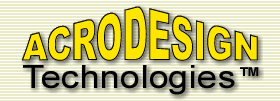





![]()
![]()
Are you preparing for the wireless revolution? We are! Here at AcroDesign Technologies, we are creating enabling technologies for the emerging personal-area networking markets. Personal-area networking will emerge as a result of the introduction of consumer devices with built-in wireless technology such as Bluetooth. These devices will be able to communicate with each other, and with user-interface devices such as a PC, or handheld computer. We believe that the PDA will become a key device in the personal-area networking market as a standard interface between the user and the devices that surround them.
What will personal-area networking platforms look like? In the scenario described above, we see two distinct types of personal-area networking devices. First, there are numerous wireless appliance devices that perform application-specific tasks. These devices do not necessarily have a lot of computation power and/or user-interface elements and take advantage of wireless technology to access remote resources such as computation, data, or user-interface hardware. Second, there are a fewer number of wireless extension devices that provided the resources needed by the appliance devices. As previously mentioned, the PDA will be a key player in the extension device space. Our approach is to off-load as much functionality as possible to the extension devices and minimize the costs of the numerous appliance devices. Appliance devices can achieve their desired functionality by uploading the necessary software to the extension device as needed, or by requiring the user to install certain software on the extension device. Our mission is to create innovative development tools that address each of these two distinct roles (appliance vs. extension devices). To that end, we are developing the X-AcuteTM software development platform to address the extension device space, and the Tcl on BoardTM embedded platform to address the appliance space.
The X-Acute platform consists of a very high-level language and standard communication protocols that will enable the rapid development of robust applications. The X-Acute tools are being developed from the ground up to target the PDA devices that will be so important in personal-area networking. The following is a list of some of the key attributes of the X-Acute platform that make it ideal for personal-area networking extension devices:
A prototype version of the Tcl on Board platform is now complete. The goal of this platform is to bring the benefits of high-level programming languages to the low- to mid-range embedded systems market. There are a number of significant advantages to using a high-level language for embedded software design, such as the following:
In order to reconcile the performance trade-offs of using a high-level language, the Tcl on Board! platform is based on a language-specific processor for the Tcl language. The prototype Tcl processor has been implemented on a Xilinx Spartan IIe development board. The processor can achieve speeds up to 36 MHz and occupies approximately 30k gates.
The prototype platform includes a minimal implementation of the PPP and TCP/IP protocols for single connections. An embedded Web server application has been successfully implemented using the Tcl on Board! platform with about 1 page of Tcl code. The Web server application implements an example user interface to a hypothetical climate control system. Using a standard browser, the user can connect to the embedded server to view the current multi-zone settings and to submit changes.
Initial results from our Tcl on Board! development were presented at the Tcl/Tk 2002 Conference in Vancouver, CA. The presentation is available as a PowerPoint file.